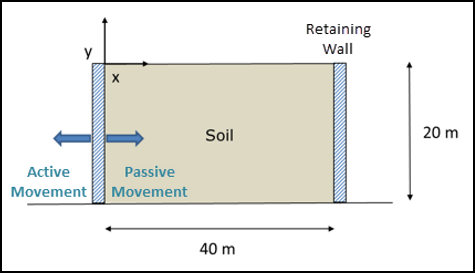Earth pressure is determined by the weight of the soil, soil depth, and depth of water table. The effective stress of the soil is:
(48–1) |
where is the total stress,
is the effective stress, and
is the pore pressure.
The horizontal stress coefficient of earth pressure is:
(48–2) |
Depending on the state of the soil, three different coefficients can be defined
, which are the at rest, active, and passive pressures,
respectively.
The active and passive lateral earth pressure on a horizontally displaced retaining wall is calculated. The retained backfill consists of a sand-like soil with little cohesion.
Initially, the at rest stress state is applied by considering the gravitational acceleration of the soil. Afterwards, two stress states are generated.
A fully developed active earth-pressure state is created by moving the retaining wall away from the soil. In this case, the lateral stress starts from a certain value and decreases until it reaches the active earth pressure value.
A fully developed passive earth-pressure state is produced by moving the retaining wall towards the soil. Both stress states are strongly influenced by the plastic deformation of the retained soil. In this case, the lateral stress starts from a certain value and increases until it reaches the passive earth pressure value.
No water table is considered in this example problem.



